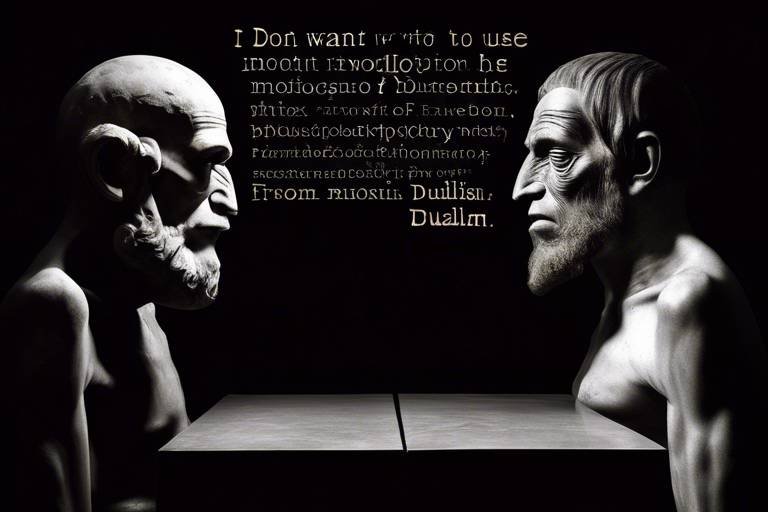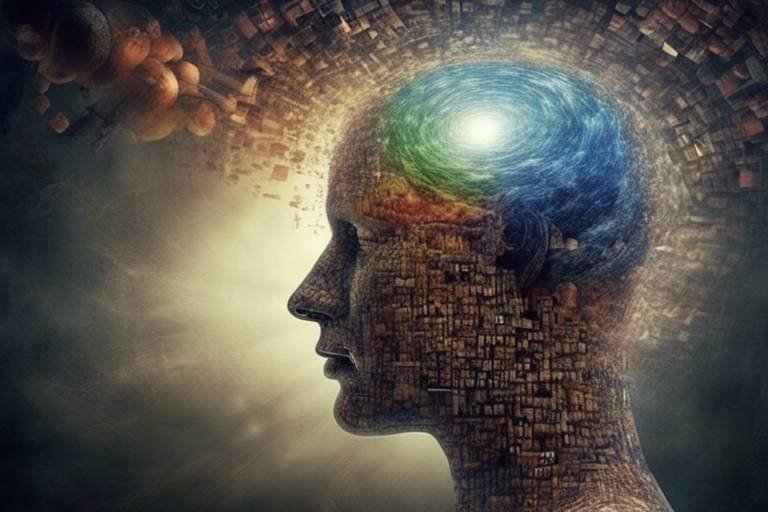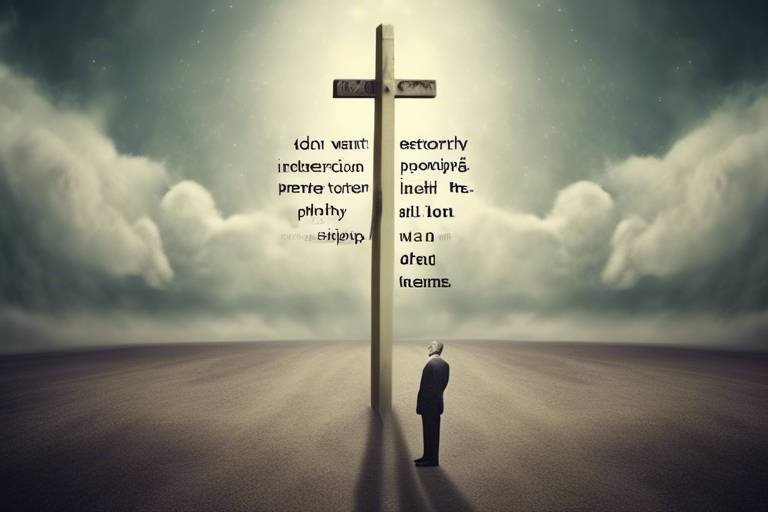From Dualism to Monism - The Evolution of Mind Philosophy
The journey from dualism to monism is not just a philosophical debate; it’s a profound exploration of what it means to be human. Imagine standing at the crossroads of thought, where the mind and body are viewed as either separate entities or as one cohesive unit. This article dives deep into this philosophical evolution, exploring key concepts, influential thinkers, and the implications this has on our understanding of the mind-body relationship in contemporary thought. The transition from dualism to monism reflects a shift in how we perceive our existence, consciousness, and the very fabric of reality itself.
At its core, dualism asserts a sharp divide between the mind and the body. This idea, primarily attributed to René Descartes, posits that our mental processes are fundamentally different from our physical existence. Historically, dualism can be traced back to ancient philosophical traditions, but it gained significant traction in the 17th century with Descartes' influential writings. His famous assertion, "Cogito, ergo sum"—I think, therefore I am—highlights the supremacy of thought as the essence of human identity. But why is this separation significant? It raises essential questions about how we experience life, understand consciousness, and navigate the complexities of human existence.
Throughout history, several key philosophers have shaped the discourse surrounding dualism. René Descartes stands out as a pivotal figure, laying the groundwork for dualistic thought. His arguments not only defined the mind-body relationship but also opened the door for later philosophical developments. Other notable thinkers, such as Plato and Kant, also contributed to this dialogue, each adding their unique perspectives on the nature of reality and existence. Their collective insights have created a rich tapestry of thought that continues to influence contemporary philosophy.
René Descartes' famous dictum "Cogito, ergo sum" emphasizes the primacy of thought. This profound assertion serves as the foundation of his dualistic philosophy, suggesting that self-awareness is the key to understanding existence. Descartes argued that the mind, as a non-physical entity, stands apart from the physical world. This separation raises intriguing questions: If the mind and body are distinct, how do they interact? What does this mean for our understanding of consciousness? Descartes' exploration of these questions laid the groundwork for centuries of philosophical inquiry.
The notion of the mind as a non-physical substance challenges the physicalist perspective, which posits that everything can be explained through physical processes. Dualism posits that the mind exists independently of the body, leading to fascinating discussions about the nature of reality. If the mind is non-physical, how does it influence our actions, emotions, and thoughts? This perspective invites us to reconsider our understanding of existence, consciousness, and the interplay between mental and physical phenomena.
Despite its historical significance, dualism faces substantial critiques. Critics argue that dualism fails to account for the interaction between mind and body, leading to what is known as the "interaction problem." How can an immaterial mind influence a material body? This question has prompted philosophers to seek alternative frameworks, pushing the boundaries of philosophical thought. As we explore these critiques, we begin to see the emergence of monism as a compelling alternative.
Monism presents a unified perspective on mind and body, suggesting they are not fundamentally separate. This philosophical shift emerged as thinkers began to seek a more integrated understanding of existence. Monism posits that everything is part of a single substance or reality, challenging the dualistic notion of separation. As we delve into the historical emergence of monistic thought, we uncover its philosophical significance and how it reshapes our understanding of consciousness and reality.
Key figures like Baruch Spinoza have been instrumental in advocating monistic philosophy. Spinoza's radical departure from dualism presents a view of a single substance encompassing both mind and body. His ideas challenge traditional separations and highlight the interconnectedness of all existence. Understanding Spinoza's contributions allows us to appreciate the philosophical shift from dualistic to monistic perspectives in the philosophy of mind.
Spinoza's concept of substance monism suggests that there is only one substance, which manifests as both mind and body. This radical perspective invites us to reconsider our understanding of existence and consciousness. By viewing mind and body as two attributes of the same substance, Spinoza offers a holistic approach that emphasizes the unity of all things. This shift has profound implications for how we perceive our place in the universe and our interconnectedness with everything around us.
Modern philosophy continues to evolve, with many thinkers advocating for monistic views. Current debates reflect the enduring influence of monism in understanding consciousness and reality. As we explore these contemporary perspectives, we see how the dialogue surrounding the mind-body relationship remains vibrant and relevant. The evolution from dualism to monism not only reshapes philosophical thought but also impacts fields such as psychology, neuroscience, and cognitive science.
- What is dualism? Dualism is the philosophical concept that the mind and body are distinct and separate entities.
- Who is the most influential philosopher associated with dualism? René Descartes is often regarded as the most influential figure in dualistic philosophy.
- What is monism? Monism is the belief that mind and body are not separate but are two aspects of a single substance or reality.
- How does monism affect our understanding of consciousness? Monism encourages a holistic view of consciousness, emphasizing the interconnectedness of all aspects of existence.

The Roots of Dualism
Dualism, a term that often evokes images of a sharp divide, has its philosophical roots deeply embedded in the thoughts of early thinkers. Primarily attributed to the renowned philosopher René Descartes, dualism posits a distinct separation between the mind and body. This notion suggests that our mental processes are fundamentally different from our physical states, leading to a complex relationship between consciousness and the material world. But where did this idea originate? To understand dualism's historical context, we must journey back to the early modern period, a time characterized by a burgeoning interest in science, reason, and individual experience.
In the 17th century, as the scientific revolution began to take shape, thinkers like Descartes sought to reconcile the emerging scientific understanding of the physical world with the enduring questions of existence and consciousness. Descartes famously declared, "Cogito, ergo sum" (I think, therefore I am), which underscores the belief that the act of thinking is proof of one's existence. This assertion not only highlights the primacy of thought but also reinforces the idea that the mind exists in a realm separate from the body. The implications of this separation are profound, as they suggest that our mental experiences cannot be fully explained by physical processes alone.
The implications of dualism extend beyond mere philosophical musings; they permeate our understanding of human experience. By maintaining a divide between mind and body, dualism raises significant questions about the nature of reality and existence. For instance, if the mind is a non-physical entity, how does it interact with the physical body? This conundrum has led to various interpretations and critiques of dualism, as philosophers grapple with the complexities of consciousness and its relationship to the physical world.
As we delve deeper into the roots of dualism, it's essential to recognize its historical significance. The dualistic framework not only influenced philosophical discourse but also shaped the development of various fields, including psychology, theology, and ethics. Understanding this historical backdrop allows us to appreciate the evolution of thought that eventually paved the way for alternative frameworks, such as monism, which we will explore later.
In summary, dualism's roots are entwined with the philosophical inquiries of the past, particularly those of Descartes and his contemporaries. The separation of mind and body continues to provoke debate and discussion, raising fundamental questions about the nature of consciousness and our understanding of reality. As we move forward in our exploration of this topic, we must consider how these early ideas have influenced modern thought and the ongoing quest to bridge the gap between mind and body.

Key Philosophers in Dualism
When we think about dualism, one name that immediately springs to mind is René Descartes. His profound influence on the philosophy of mind cannot be overstated. Descartes famously articulated the idea of dualism through his assertion that the mind and body are fundamentally distinct entities. This perspective, which he elaborated in works like Meditations on First Philosophy, set the stage for a long-standing debate that has echoed through the ages.
Descartes' dualism is often summarized by his famous phrase Cogito, ergo sum—"I think, therefore I am." This statement encapsulates his belief that the act of thinking is the undeniable proof of one's existence and consciousness. In Descartes' view, the mind is a non-physical substance, entirely separate from the physical body. This raises intriguing questions about how these two distinct substances interact. How can something immaterial influence something material? This question has puzzled philosophers for centuries and has led to various interpretations and critiques of dualism.
Another pivotal figure in the realm of dualism is Gottfried Wilhelm Leibniz. He introduced the idea of pre-established harmony, suggesting that while the mind and body are separate, they operate in perfect synchronization as if they were choreographed by a divine force. Leibniz argued that the mind and body do not interact directly but are instead aligned in a harmonious relationship, much like two perfectly timed dancers moving in sync without ever touching. This concept provided a unique perspective on the dualistic framework, attempting to address some of the criticisms aimed at Descartes.
Moving into the 19th century, we encounter Immanuel Kant, who, while not a dualist in the strictest sense, contributed significantly to the discussion surrounding the mind-body problem. Kant proposed a nuanced view, suggesting that our understanding of the world is shaped by the way our mind interacts with sensory experiences. He introduced the idea of phenomena (the world as we perceive it) and noumena (the world as it is in itself), creating a complex interplay between the mind and the external world. This distinction added another layer to the dualistic discourse, illustrating the challenges in reconciling subjective experience with objective reality.
In addition to these foundational thinkers, there are others who have shaped the dualistic landscape. David Hume, for instance, critiqued the notion of a permanent self, arguing that what we perceive as the mind is merely a collection of perceptions and experiences. This skepticism towards the dualistic separation of mind and body prompted further exploration into the nature of consciousness and existence.
In summary, the key philosophers of dualism have laid the groundwork for an ongoing exploration of the mind-body relationship. Their diverse perspectives, from Descartes' clear division of substances to Leibniz's harmonious synchronization and Kant's complex interplay of perception, illustrate the rich tapestry of thought that characterizes this philosophical journey. Each of these thinkers has contributed to a deeper understanding of not only dualism but also the fundamental questions surrounding human experience and existence.
- What is dualism? Dualism is the philosophical concept that posits a distinction between the mind and body, suggesting they are separate entities.
- Who is the most famous dualist philosopher? René Descartes is often regarded as the most influential dualist philosopher.
- What are the main critiques of dualism? Critics argue that dualism fails to explain how the non-physical mind can interact with the physical body, leading to alternative philosophical frameworks.
- How does dualism relate to modern philosophy? While dualism has faced challenges, its ideas continue to influence contemporary discussions about consciousness and the nature of reality.

Descartes and the Cogito
René Descartes, a towering figure in Western philosophy, introduced a revolutionary idea that has echoed through the corridors of intellectual history: Cogito, ergo sum, which translates to "I think, therefore I am." This simple yet profound statement encapsulates the essence of Descartes' dualistic philosophy, establishing a clear distinction between the mind and the body. At its core, this assertion suggests that the very act of thinking is proof of one's existence. But why is this so significant?
To understand the weight of Descartes' claim, we must plunge into the philosophical waters of the 17th century. During this time, many thinkers grappled with the nature of existence, reality, and the self. Descartes' approach was radical; he sought to establish a foundation for knowledge that was immune to doubt. He famously employed a method of radical skepticism, questioning everything he believed to be true until he arrived at an undeniable certainty: his own thoughts. This led him to conclude that while the physical world could be an illusion, the very act of doubting or thinking confirmed his existence as a conscious being.
Descartes' dualism posits that the mind is a non-physical substance, distinct from the body, which is physical. This separation raises intriguing questions about the nature of consciousness and its relationship with the physical world. If the mind is non-physical, how does it interact with the body? This is where things get complicated. Critics of dualism argue that if the mind and body are fundamentally different substances, it becomes challenging to explain how they influence each other. For example, when you feel pain (a physical experience), how does that relate to your thoughts and feelings (non-physical experiences)?
Despite these challenges, Descartes' cogito remains a cornerstone of modern philosophy. It invites us to reflect on our own existence and the nature of consciousness. The implications of his work extend beyond philosophy, influencing fields such as psychology, cognitive science, and even artificial intelligence. By asserting that the mind is separate from the body, Descartes opened the door for future discussions about the self, identity, and the essence of being.
In summary, Descartes and his cogito not only shaped the philosophical landscape of his time but also laid the groundwork for ongoing debates about the mind-body relationship. His insistence on the primacy of thought as proof of existence challenges us to consider what it means to be truly aware and how our minds interact with the physical world around us. The journey from dualism to monism may have begun with Descartes, but the questions he raised continue to resonate today.

Cogito, ergo sum
When we hear the phrase , or "I think, therefore I am," it resonates with the essence of human existence. This profound statement by René Descartes serves as a cornerstone of dualistic philosophy, emphasizing the significance of thought and self-awareness. Descartes proposed that the very act of thinking is proof of one's existence; if you are capable of doubt, reflection, or contemplation, then you undeniably exist. This assertion is not merely a philosophical musing but a declaration that places the mind at the forefront of our understanding of reality.
In the context of dualism, Descartes' philosophy suggests that the mind is a distinct entity, separate from the physical body. He argued that while the body is subject to the laws of nature, the mind operates on a different plane, free from physical constraints. This separation raises intriguing questions about consciousness and identity. If our thoughts and feelings exist independently of our physical form, what does that imply about our nature as human beings? Are we merely biological organisms, or is there something more profound that defines our existence?
Descartes' exploration of the mind-body relationship led to further inquiries into the nature of reality itself. He famously doubted everything that could be doubted until he arrived at a fundamental truth: the certainty of his own existence as a thinking being. This philosophical breakthrough not only shaped his own work but also influenced countless thinkers who followed. It sparked debates that still linger today, questioning whether the mind can exist without the body, or vice versa.
To better understand Descartes' impact, let’s consider some key implications of his Cogito:
- Existential Certainty: The mind's ability to think is the ultimate proof of existence.
- Separation of Mind and Body: The mind is non-physical, suggesting a dualistic nature of human existence.
- Foundation for Modern Philosophy: Descartes' ideas laid the groundwork for subsequent philosophical exploration into consciousness.
However, while Descartes' assertion is powerful, it also invites critique. The notion that the mind can exist independently of the body raises significant questions about the interaction between the two. How can a non-physical mind influence a physical body? This inquiry has led philosophers to explore alternative frameworks, such as monism, which posits that mind and body are not fundamentally separate but rather two aspects of the same reality.
In essence, Descartes' is not just a philosophical statement; it’s a profound exploration of existence that challenges us to reflect on the nature of consciousness. It compels us to ask: What does it mean to be aware? How do our thoughts shape our reality? These questions have propelled the evolution of philosophical thought, paving the way for future discussions on the mind-body relationship.
- What does "Cogito, ergo sum" mean?
This Latin phrase translates to "I think, therefore I am," signifying that the act of thinking is proof of one's existence. - Who is René Descartes?
René Descartes was a French philosopher, mathematician, and scientist, known as the father of modern philosophy. - How does dualism differ from monism?
Dualism posits a separation between mind and body, while monism argues that they are interconnected aspects of the same reality. - Why is Descartes' philosophy important?
His ideas laid the groundwork for modern philosophical inquiry into consciousness, identity, and the nature of reality.

emphasizes the primacy of thought. This subheading explores how his assertion of self-awareness underpins dualistic philosophy and its implications for understanding consciousness.
Dualism, primarily attributed to Descartes, posits a distinct separation between mind and body. This section delves into its historical origins and the philosophical implications of maintaining such a divide in understanding human experience.
This section highlights influential philosophers like René Descartes and their contributions to dualistic thought. Their arguments shaped the discourse around the mind-body relationship and set the stage for later philosophical developments.
René Descartes' famous dictum Cogito, ergo sum emphasizes the primacy of thought. This assertion is not just a catchy phrase; it's a profound statement about self-awareness and existence. Descartes argues that the very act of thinking is proof of one’s existence. It's like saying, "If I can doubt, then I must be thinking; if I am thinking, I must exist." This pivotal idea underpins dualistic philosophy by suggesting that the mind, as a thinking entity, is fundamentally different from the physical body. In this light, the mind is a non-physical substance, a realm of thought and consciousness that operates independently of the material world.
Descartes' assertion raises intriguing implications for understanding consciousness. By placing thought at the center of existence, he invites us to ponder questions like: What does it mean to be conscious? How do our thoughts influence our physical actions? This separation of mind and body leads to a complex dialogue about how these two entities interact. For instance, consider how emotions can cause physical reactions—like blushing or sweating—yet the mind remains an intangible aspect of our being. This dualistic framework challenges us to explore the nature of reality and existence itself.
This section examines the notion of the mind as a non-physical entity, discussing how this view challenges physicalist perspectives and raises questions about the nature of reality and existence.
Critics argue that dualism fails to account for the interaction between mind and body. This part discusses various objections to dualistic philosophy and the push towards alternative frameworks.
Monism presents a unified perspective on mind and body, suggesting they are not fundamentally separate. This section explores the historical emergence of monistic thought and its philosophical significance.
This section focuses on key figures like Baruch Spinoza and their contributions to monistic philosophy. Understanding their ideas helps illustrate the shift from dualistic to monistic perspectives in the philosophy of mind.
Spinoza's view of a single substance encompassing both mind and body offers a radical departure from dualism. This subheading discusses his arguments and their implications for understanding the interconnectedness of existence.
Modern philosophy continues to evolve, with many thinkers advocating for monistic views. This section examines current debates and how contemporary philosophies reflect the enduring influence of monism in understanding consciousness and reality.
- What is dualism? Dualism is the philosophical belief that the mind and body are distinct and separate entities.
- Who is the main proponent of dualism? René Descartes is widely regarded as the key figure in dualistic philosophy.
- What does 'Cogito, ergo sum' mean? It translates to 'I think, therefore I am,' highlighting the importance of thought in establishing existence.
- What is monism? Monism is the belief that mind and body are unified and not fundamentally separate.
- How does modern philosophy view dualism and monism? Contemporary thinkers often explore a blend of both perspectives, examining how they influence our understanding of consciousness and reality.

Mind as a Non-Physical Substance
The concept of the mind as a non-physical substance is a cornerstone of dualistic philosophy, challenging our traditional understanding of reality. Imagine for a moment that the mind is like a ghostly presence, ethereal and intangible, yet profoundly influential in shaping our experiences and actions. This idea suggests that the mind operates independently from the physical body, which raises fascinating questions about existence itself. If the mind is non-physical, what does that imply for our understanding of consciousness and the self?
René Descartes famously articulated this view, proposing that the mind (or soul) exists in a realm separate from the body. He argued that while our bodies are composed of matter, subject to the laws of physics, the mind transcends these limitations. This separation posits that our thoughts, emotions, and consciousness are not merely products of biological processes but rather exist in a distinct plane. Such a perspective invites us to ponder the nature of reality: if the mind is separate, how do these two realms interact? This question has perplexed philosophers for centuries and continues to fuel debates in contemporary philosophy.
Critics of dualism argue that viewing the mind as a non-physical substance creates a significant gap in understanding how mental and physical states influence each other. For instance, when we feel pain (a physical sensation), how does that relate to our thoughts about that pain? This relationship becomes murky under dualism, leading to the infamous 'mind-body problem.' The challenge lies in explaining the mechanisms behind the interaction between the two realms. Some philosophers have attempted to bridge this gap through various theories, such as interactionism, which suggests that the mind can influence the body and vice versa.
Furthermore, the notion of a non-physical mind raises intriguing implications for our understanding of identity and existence. If our thoughts and consciousness are not bound by physical laws, does that mean we possess a form of immortality? Could our minds exist independently of our bodies after death? These questions not only challenge our perceptions of life and death but also influence fields such as psychology, neuroscience, and even spirituality.
In contemporary discussions, many thinkers advocate for a more integrated approach, suggesting that rather than viewing the mind and body as separate entities, we should explore how they coexist and interact. This shift towards understanding the mind as part of a larger system reflects a growing recognition of the complexities of human experience. As we delve deeper into the mysteries of consciousness, the dialogue between dualism and monism continues to evolve, inviting new perspectives and insights into the nature of existence.

Critiques of Dualism
While dualism has played a significant role in shaping philosophical thought, it is not without its critics. Many philosophers and scientists have raised important questions regarding the viability of a strict separation between the mind and body. One of the most pressing critiques is the challenge of understanding how two fundamentally different substances—mental and physical—can interact. If the mind is non-physical and the body is physical, how do they communicate? This question has puzzled thinkers for centuries and remains a critical point of contention.
Moreover, critics argue that dualism leads to a host of other philosophical dilemmas. For instance, if the mind exists independently of the body, what happens to the mind after death? This inquiry not only raises metaphysical questions but also touches on ethical considerations about life and existence. Additionally, the dualistic framework struggles to explain phenomena such as consciousness and perception. How can subjective experiences arise from a non-physical mind interacting with a physical body? This conundrum has led many to question the coherence of dualistic thought.
Another significant critique involves the advancements in neuroscience. As our understanding of the brain evolves, evidence increasingly suggests that mental states correlate with physical states in the brain. Research in neurobiology indicates that emotions, thoughts, and consciousness are deeply intertwined with brain activity. This growing body of evidence challenges the dualistic view by providing a more unified understanding of the mind-body relationship.
Furthermore, dualism can lead to a form of reductionism, where the complexities of human experience are oversimplified. Critics argue that by insisting on a separation, dualism overlooks the rich interconnections between mental and physical processes. For instance, consider the experience of pain. It is not merely a physical sensation but also has emotional and psychological components. By separating these experiences, dualism may inadvertently ignore the holistic nature of human existence.
In summary, while dualism has offered valuable insights into the mind-body relationship, it faces substantial critiques that question its validity and applicability in contemporary thought. These critiques have paved the way for alternative frameworks, such as monism, which seeks to provide a more integrated understanding of consciousness and existence.
- What is dualism? Dualism is a philosophical concept that posits a distinct separation between the mind and body, suggesting they are fundamentally different substances.
- Who are the key philosophers associated with dualism? René Descartes is one of the most prominent figures associated with dualism, particularly known for his statement "Cogito, ergo sum."
- What are the main critiques of dualism? Critics argue that dualism struggles to explain the interaction between mind and body, overlooks the complexities of human experience, and is challenged by advancements in neuroscience.
- What is monism? Monism is the philosophical perspective that suggests the mind and body are not fundamentally separate but rather exist as different aspects of the same substance or reality.

Emergence of Monism
The philosophical landscape has undergone a fascinating transformation over the centuries, particularly in the realm of understanding the mind-body relationship. As thinkers grappled with the limitations and challenges posed by dualism, a new perspective began to take shape—monism. This unified approach posits that mind and body are not distinct entities but rather intertwined aspects of a singular reality. The emergence of monism marks a significant shift in philosophical discourse, reflecting a deeper inquiry into the essence of existence itself.
Historically, monism can be traced back to ancient philosophical traditions, yet it gained substantial momentum during the Enlightenment and the subsequent modern era. Thinkers like Baruch Spinoza played a pivotal role in articulating monistic views, arguing against the dualistic separation of mind and body. Spinoza proposed that everything that exists is part of a single substance, which he referred to as "God or Nature." This radical departure from dualism not only challenged the prevailing notions of the time but also laid the groundwork for future explorations into the nature of reality.
One of the core tenets of monism is the idea that mental and physical states are fundamentally interconnected. This perspective invites us to reconsider how we perceive consciousness and existence. Rather than viewing the mind as a separate, non-physical entity, monism encourages us to see it as an integral part of the physical world. This shift in thinking has profound implications for various fields, including psychology, neuroscience, and metaphysics.
Additionally, the emergence of monism has sparked ongoing discussions about the implications for understanding consciousness. As we delve into contemporary debates, it becomes clear that monistic perspectives are gaining traction among modern philosophers and scientists alike. Many argue that a monistic framework provides a more cohesive understanding of human experience, bridging the gap between subjective mental states and objective physical phenomena.
To illustrate the evolution of thought from dualism to monism, consider the following table that highlights key differences between the two philosophies:
| Aspect | Dualism | Monism |
|---|---|---|
| Nature of Reality | Mind and body are separate entities | Mind and body are unified aspects of a single substance |
| Understanding Consciousness | Consciousness is non-physical | Consciousness emerges from physical processes |
| Philosophical Implications | Challenges in explaining mind-body interaction | Promotes a holistic understanding of existence |
In conclusion, the emergence of monism signifies a profound evolution in philosophical thought, moving from the rigid boundaries of dualism to a more integrated understanding of mind and body. As contemporary thinkers continue to explore these ideas, it is evident that monism offers a compelling framework for addressing some of the most pressing questions about consciousness and reality. This ongoing dialogue not only enriches philosophical inquiry but also enhances our understanding of what it means to be human in a complex, interconnected world.
- What is the main difference between dualism and monism?
Dualism posits that mind and body are separate entities, while monism asserts that they are unified aspects of a single reality. - Who are the key philosophers associated with monism?
Baruch Spinoza is one of the most notable philosophers advocating monistic thought, but many modern thinkers also support this perspective. - How does monism influence contemporary discussions on consciousness?
Monism encourages a more holistic understanding of consciousness, suggesting it arises from physical processes rather than being a separate, non-physical entity.

Philosophers Advocating Monism
Monism, a philosophical perspective that suggests a unified view of reality, has been championed by several influential thinkers throughout history. These philosophers have not only challenged the dualistic notion that separates mind and body but have also provided frameworks that encourage a deeper understanding of existence itself. By advocating for a singular substance or essence that encompasses both mental and physical realms, they have paved the way for contemporary discussions about consciousness and reality.
One of the most notable figures in the realm of monistic philosophy is Baruch Spinoza. Spinoza's radical ideas about substance monism propose that everything in the universe, including mind and body, is part of a single, infinite substance. He famously stated that "God or Nature" is the same, suggesting that the divine and the natural world are not separate entities but rather different expressions of the same underlying reality. This perspective invites us to reconsider our relationship with the world around us, highlighting the interconnectedness of all things.
Another key advocate of monism is Gottfried Wilhelm Leibniz. While he is often associated with his theory of monads—simple substances that make up reality—Leibniz also emphasized that these monads do not interact in a traditional sense but rather reflect the entire universe from their unique perspectives. This idea challenges the dualistic notion of interaction between mind and body, suggesting instead a harmonious pre-established order orchestrated by a divine creator.
In modern philosophy, thinkers such as David Papineau and Daniel Dennett have revived monistic ideas through their discussions on consciousness and physicalism. Papineau argues for a naturalistic view of consciousness that aligns with monistic principles, suggesting that mental states are indeed physical states, thus bridging the gap between the mind and body. Dennett, on the other hand, emphasizes the role of evolutionary biology in understanding consciousness, proposing that our awareness is a product of complex physical processes rather than a separate, immaterial entity.
As we delve deeper into monistic philosophy, it becomes clear that these thinkers are not merely advocating for a new way of understanding the mind-body relationship; they are also challenging us to rethink our assumptions about reality. By embracing a monistic perspective, we can begin to dissolve the artificial barriers that have long divided our understanding of existence. This shift not only has implications for philosophy but also for science, psychology, and spirituality, encouraging an integrated approach to exploring the mysteries of consciousness.
In summary, the evolution from dualism to monism reflects a significant paradigm shift in how we perceive the mind-body relationship. The contributions of philosophers like Spinoza, Leibniz, Papineau, and Dennett illustrate the richness and complexity of monistic thought, inviting us to engage with questions that lie at the very heart of human experience.
- What is monism? Monism is the philosophical view that all things are interconnected and that there is a single substance or essence that constitutes reality.
- How does monism differ from dualism? While dualism posits a separation between mind and body, monism suggests that they are two aspects of the same underlying reality.
- Who are some key philosophers associated with monism? Notable philosophers include Baruch Spinoza, Gottfried Wilhelm Leibniz, David Papineau, and Daniel Dennett.
- What are the implications of monism for understanding consciousness? Monism encourages a more integrated approach to consciousness, suggesting that mental states are fundamentally linked to physical states.

Spinoza's Substance Monism
Baruch Spinoza, a towering figure in the world of philosophy, introduced a revolutionary concept known as Substance Monism. Unlike the dualistic perspective that posits a sharp division between mind and body, Spinoza argued that everything in existence is part of a single, unified substance. Imagine a vast ocean, where each wave represents an individual thought or physical object; while they appear distinct, they are ultimately expressions of the same underlying reality. This radical idea not only challenged the prevailing views of his time but also laid the groundwork for modern discussions on the nature of existence.
At the heart of Spinoza's philosophy is the assertion that there is only one substance, which he identified as God or Nature (Deus sive Natura). This substance is infinite, self-causing, and encompasses everything that exists. In his view, mind and body are not separate entities but rather two attributes of this singular substance. To illustrate this, consider the following:
| Attribute | Description |
|---|---|
| Mind | The thinking aspect of the substance, encompassing thoughts, ideas, and consciousness. |
| Body | The extended aspect of the substance, comprising physical matter and spatial existence. |
This perspective has profound implications for how we understand reality. If mind and body are merely two ways of perceiving the same substance, then the boundaries that separate them begin to blur. Spinoza's monism invites us to reconsider our relationship with the world around us. Instead of viewing the mind as a ghostly presence inhabiting a physical shell, we start to see a more integrated, holistic view of existence.
Moreover, Spinoza's ideas can be seen as a precursor to modern scientific thought. In a world that increasingly values empirical evidence and interconnectedness, his philosophy resonates with contemporary understandings of the universe as a complex web of interactions. Just as physicists now explore the connections between energy and matter, Spinoza's monism encourages us to explore the connections between thought and physical reality.
However, embracing Spinoza's Substance Monism also raises challenging questions. If everything is part of a single substance, how do we account for the diversity of experiences and perceptions? How do we navigate the complexities of human emotions, desires, and consciousness within this unified framework? These questions continue to spark debate among philosophers and scientists alike, illustrating the enduring relevance of Spinoza's thought.
In conclusion, Spinoza's Substance Monism represents a significant shift in the philosophical landscape. By proposing a unified view of mind and body, he not only challenged the dualistic framework but also opened the door for future explorations into the nature of consciousness and existence. His ideas encourage us to look beyond the surface and recognize the intricate connections that bind all aspects of reality together.
- What is Substance Monism? Substance Monism is the philosophical view that there is only one substance that constitutes reality, encompassing both mind and body as two attributes of that substance.
- How does Spinoza's view differ from Descartes' dualism? While Descartes posited a distinct separation between mind and body, Spinoza argued that they are two aspects of the same underlying substance.
- What implications does Substance Monism have for modern science? Spinoza's ideas encourage a holistic view of reality, which aligns with contemporary scientific explorations of interconnectedness in the universe.

Contemporary Perspectives on Monism
In today’s philosophical landscape, the concept of monism is experiencing a resurgence, as thinkers grapple with the complexities of consciousness and reality. Unlike dualism, which maintains a strict separation between mind and body, monism offers a more integrated view, suggesting that everything in existence is interconnected. This perspective resonates with various disciplines, including psychology, neuroscience, and even quantum physics, as they all seek to understand the intricate relationship between mind and matter.
One of the most compelling aspects of contemporary monism is its alignment with scientific advancements. For instance, the field of neuroscience has made significant strides in demonstrating how mental states correlate with brain activity. This has led many to argue that our understanding of consciousness can no longer be viewed through the lens of dualism, which separates mental processes from physical ones. Instead, the monistic approach posits that consciousness arises from complex interactions within the brain, emphasizing the idea that the mind is not a separate entity but rather a product of physical processes.
Prominent philosophers today, such as Daniel Dennett and Patricia Churchland, advocate for a monistic view that integrates insights from both philosophy and science. Dennett, for example, argues that consciousness is a narrative constructed by the brain, a perspective that challenges traditional dualistic notions. Churchland further emphasizes the importance of understanding the brain's physical processes to grasp the nature of consciousness, asserting that our mental experiences are deeply rooted in neurobiological functions.
Moreover, contemporary discussions on monism often intersect with Eastern philosophical traditions, particularly those found in Buddhism and Taoism. These traditions have long embraced the idea of interconnectedness and the non-dual nature of reality, suggesting that the separation between mind and body is an illusion. This convergence of Western and Eastern thought enriches the monistic discourse, offering a holistic view that transcends cultural boundaries.
To illustrate the evolution of monistic thought, consider the following table that summarizes key contemporary perspectives:
| Philosopher | Key Ideas | Contribution to Monism |
|---|---|---|
| Daniel Dennett | Consciousness as a narrative | Challenges dualism by emphasizing the brain's role in constructing experiences. |
| Patricia Churchland | Neurophilosophy | Integrates neuroscience with philosophy to explain consciousness and mind. |
| David Chalmers | The hard problem of consciousness | Explores the relationship between physical processes and subjective experiences. |
| Alva Noë | Enactive approach to perception | Suggests that consciousness arises from the interaction between the brain and the environment. |
This table highlights how various philosophers contribute to the monistic perspective, each offering unique insights that challenge traditional dualistic frameworks. As we move forward, the dialogue around monism continues to evolve, inviting new questions and perspectives that push the boundaries of our understanding.
In conclusion, contemporary perspectives on monism not only reflect a shift in philosophical thought but also resonate with scientific discoveries and ancient wisdom. By embracing a unified view of mind and body, we open ourselves to a richer understanding of consciousness and existence, paving the way for future explorations in both philosophy and science.
Frequently Asked Questions
- What is dualism in philosophy?
Dualism is a philosophical concept that posits the existence of two distinct entities: the mind and the body. This perspective, famously associated with René Descartes, suggests that mental phenomena are non-physical and fundamentally separate from the physical body, leading to intriguing discussions about the nature of consciousness and existence.
- Who are the key philosophers associated with dualism?
René Descartes is perhaps the most notable figure in dualistic philosophy, with his famous declaration "Cogito, ergo sum" highlighting the importance of thought. Other philosophers, such as Plato and Immanuel Kant, have also contributed to dualistic thought, each offering unique insights into the mind-body relationship.
- What are the main critiques of dualism?
Critics argue that dualism struggles to explain how the mind and body interact, raising questions about how non-physical thoughts can influence physical actions. Additionally, many contend that dualism overlooks the biological and neurological underpinnings of mental processes, pushing for a more integrated understanding of consciousness.
- What is monism, and how does it differ from dualism?
Monism is the philosophical view that mind and body are not fundamentally separate but rather part of a single substance or reality. This perspective contrasts sharply with dualism by suggesting that mental and physical states are interconnected, leading to a more unified understanding of human experience.
- Who are the prominent philosophers advocating for monism?
Baruch Spinoza is a key figure in monistic philosophy, proposing that everything, including mind and body, is part of one substance. Other modern philosophers, such as David Papineau and Daniel Dennett, also support monistic views, furthering the discussion about consciousness and its relationship to the physical world.
- How has contemporary thought evolved in relation to monism?
Contemporary philosophy continues to explore monistic ideas, with many thinkers advocating for a unified understanding of mind and body. Current debates often revolve around the implications of neuroscience for our understanding of consciousness, highlighting the ongoing relevance of monistic perspectives in modern discussions about reality and existence.



















